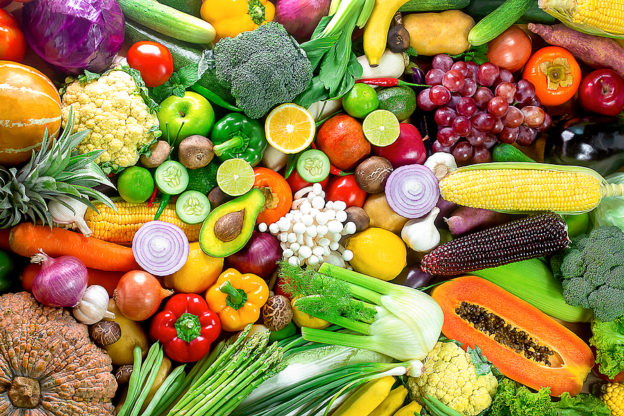By David Blyweiss, M.D., Advanced Natural Wellness
April 9, 2021
It’s an odd thing.
Humans have been eating fruits and vegetables for thousands of years. All kinds and colors of them, and in great quantity.
Today we don’t eat fruits and veggies that way.
First off, we don’t eat nearly as much colorful plant-based foods as we used to, even from a few generations ago.
Second, people tend to limit themselves to eating the same produce over and over again. They might eat broccoli, corn, green beans and green salads on a regular basis. Maybe toss some onion, mushroom or celery in certain meals. And on occasion they’ll enjoy a favorite fruit – say a banana, orange, peach or apple.
Open your arteries, improve blood flow for a new health miracle...
Did you know your circulatory system has over 60,000 miles of arteries, veins and other blood vessels, if stretched end to end?
But as you age, your blood vessels undergo changes, which may cause them to stiffen, thicken and get clogged.
GOOD NEWS! Doctors have now identified a “Miracle Molecule” inside your arteries that helps OPEN your arteries and IMPROVE blood flow.
It’s what Dr. Valentin Fuster calls it, "One of the most important discoveries in the history of cardiovascular medicine."To you, that means...
- Healthy blood pressure
- Sharper mind and memory
- Skyrocketing energy and muscular strength
- Increased pleasure and passion in the bedroom
- Improved circulation to every cell and organ in your body
Go here to discover a new natural way to significantly boost the levels of this miracle molecule in YOUR body NOW!
What about all of those other fruits and veggies out there?
Where did all of the colors go?
This is a big deal, because a variety of colorful plant-based foods are what feed the gut microbiome. And today those friendly microbes in our guts need more help than ever!
That’s because the produce we eat today doesn’t have nearly the nutritional value it once did. Plus, we have herbicides, pesticides, poisons and hormones in our foods. That means we need even more plant-based fiber in our diets than our ancestors did.
So when you eat the same plant-based foods week after week, you aren’t doing yourself any favors. Instead, you’re hobbling the microbial diversity of your gut, which means you’re creating an inflammatory environment and potentially future allergic responses to those same foods.
Next thing you know you’re dealing with serious health concerns, like obesity, heart disease, diabetes and bowel issues.
Are You Suffering From...
- Love handles and a pot belly
- Romance that isn't what it used to
- Forgetfulness and inattention
- Low (or no) strength and endurance
- A sex drive that's shifted into neutral...or worse
If so...you may have Mature Male Burnout. Click here to discover more about this unique condition and what you can do about it.
Brought to You in Living Color
Do you remember when color TV first came out? It was amazing! It transformed television viewing. It was so bright, lively and full of life.
Well, that’s what happens when you eat from all colors of the rainbow. Your life changes. It becomes more vibrant and vivid.
That’s because you’re feeding all of those healthy microbes in your gut. They start thriving and your gut health improves exponentially.
Since the gut is where most of your immune system lives, it means you’re also going to immediately start bolstering your immune response. And in today’s world, building strong immunity is more important than ever.
So I like mixing all of the colors up every day. And it’s not just about salads!
One day I can have organic red tomatoes with yellow squash, purple eggplant and green spinach (think veggie lasagna). The next I might wok some broccoli with carrots, baby corn, red bell pepper and yellow onion with my protein of choice that day…chicken, shrimp, tofu, even beef. After you get the hang of it, wokking is easy fun and your meal is done in minutes.
It’s fun to mix and match your colors to see how many creative meals you can come up with. And there are so many choices.
| RED | Red bell pepper, red cabbage, red onion, tomatoes, radishes, red chile peppers. |
| Cherries, pomegranate, strawberries, cranberries, watermelon, blood orange, watermelon. | |
| ORANGE | Carrots, orange bell peppers, pumpkin, sweet potatoes, yams, turmeric. |
| Oranges, canteloupe, mangos, nectarines, papaya. | |
| YELLOW | Corn, ginger, squash yellow pepper, yellow onion. |
| Apples, bananas, lemon, pineapple, star fruit. | |
| PURPLE | Eggplant, purple cabbage, purple carrots, purple cauliflower, purple kale. |
| Blueberries, blackberries, boysenberries, figs, prunes, purple grapes, raisins, plums. | |
| WHITE | Beans, cauliflower, mushrooms, white onions. |
| White peaches, white nectarines. | |
| GREEN | Broccoli, Brussels sprouts, asparagus, artichoke, cabbage, bok choy, snow peas, and so much more! |
| Limes, avocado, green grapes, honeydew, kiwi. |
Eating a wide variety of these colorful fruits and vegetables is one of the best things you can do for your health.
They are high in antioxidants, promote a healthy gut microbiome, offer great immune and anti-inflammatory support, help control blood sugar, boost your circulatory system and assist you in your weight loss efforts.
This means eating them is one of the easiest things you can do to help lower your risk for chronic diseases. This includes things like cancer, cardiovascular disease, stroke, Alzheimer’s, diabetes, and age-related decline. They’ll even help protect you from viral infections.
Tips to Improve Your Rainbow Eating Results
I don’t like buying commercial fruits and vegetables. I want to avoid GMO franken-foods. And I don’t want a big dose of harmful pesticides, herbicides, and fungicides on my food. These chemicals are routinely used on commercial crops.
So as a rule of thumb, always remember to purchase organically grown fruits and veggies.
I also recommend buying from local farmers markets whenever possible. After all, the food grown down the road is likely better for me than the food shipped in from an average of 1500 miles away or worse, another country.
Last but not least, supplement your nutritional needs with the things you’re missing from your foods. This like includes vitamin C, omega-3 fatty acids, the B-vitamins, vitamin A, CoQ10, and calcium.
SOURCES:
Minich DM. A Review of the Science of Colorful, Plant-Based Food and Practical Strategies for “Eating the Rainbow”. J Nutr Metab. 2019(2):1-19.







